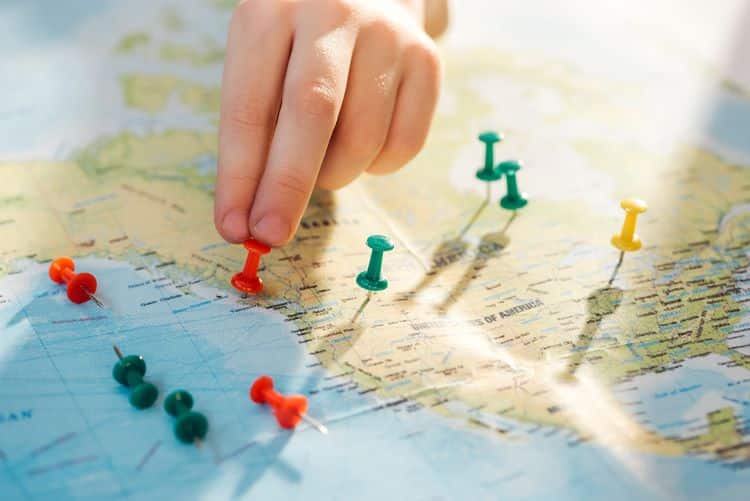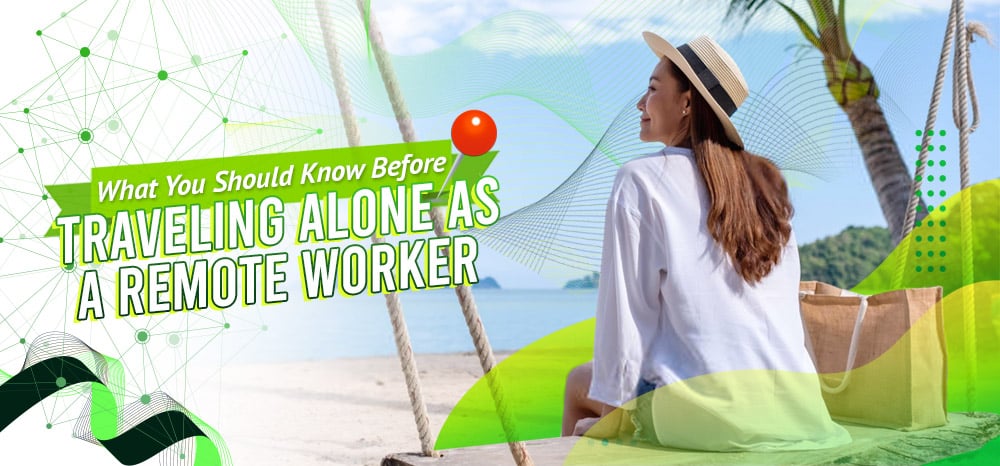Having the opportunity to travel while working is no longer a surprise if you are a remote worker.
One might even consider it a perk that comes with the job.
Still, when one thinks about traveling, they immediately think of doing it with their friends, family, or significant other.
And while there is nothing wrong with that, have you thought about traveling alone?
Here’s why you should actually do it and the logistics you need to consider before doing so.
Why Traveling Alone is a Great Idea.

The idea of going somewhere you’ve never been before by yourself is daunting.
You don’t know anyone there and you most likely don’t speak the language – if you’re going to a non-English speaking country, that is.
Thus, disadvantages can arise. For example, if you get into any trouble, lose your luggage, or feel any discomfort or pain, no one you know and trust would be there to help you.
Despite all these, traveling alone has benefits. For one, it allows you to look deep into yourself and discover new things.
You get to go outside your comfort zone and learn things about yourself without any outside influence.
Also, you get to have all this space to think, especially if you feel too bogged down with the humdrum of life.
So, if you are ready to take on the challenge, here are some things you need to take note of before buying that plane ticket.
Figure Out if You’re a Classic Digital Nomad or a “Slo-Mad”

Everyone has different preferences when it comes to traveling. After all, no two people are alike.
For remote workers, we can categorize them into two camps: the classic digital nomads and the “slo-mads.”
To start, the classic digital nomad has a long list of dream destinations they want to visit at least once in their lifetime. However, these types of remote workers tend to stay in one place very quickly—often just a few days or weeks.
Perhaps, these digital nomads want to explore as much as possible before heading back to their home countries.
Meanwhile, the “slomad” (as the name suggests) is a digital nomad who likes to take things slow. Thus, they spend their time in one country for months on end. This is an ideal set-up for people who like to really immerse themselves in the country, its people, and the culture.
So, before planning the rest of your trip, figure out which type of digital nomad you are.
Choose Your Destination

Being a remote worker has some of the best perks. You can literally work from anywhere.
And we mean, anywhere.
You could be sitting by the beach while working on your spreadsheets.
Although others might think this is not a “true” vacation (because you’re still working), for remote workers, the change of scenery is a blessing.
After all, who wants to stay at home and stare at the same wall all day long?
Of course, when it comes to choosing a destination, make sure that the country’s cost of living is within your budget. You do not want to get stranded in a foreign place with little to no money.
(Don’t forget to inform your bank ahead of time!)
Further, take note of your destination country’s visa requirements and immigration laws.
And if you can’t be bothered to research all that, then it’s best to pick a country that’s visa-free.
Create a Well-Balanced Itinerary

Of course, heading to a new destination is always exciting.
Your head might even be buzzing with ideas of where to go, what to eat, etc.
However, you shouldn’t forget to factor your work into the equation.
After all, you are not just simply traveling for pleasure, but for work too. Make sure to strike a balance when planning your itinerary.
As such, you might want to check out the area you want to stay in and see if there are any good cafes or co-working spaces.
Lastly, when creating your itinerary, creating time blocks may be useful. Schedule your work hours, and of course, any activities you want to do right after your shift.
Doing so can help avoid you getting too swamped with work that you no longer have the energy to go out and explore the city.
Check The Internet Connection

A stable Internet connection is the remote worker’s lifeline.
As such, before booking any hotels or Airbnb, make sure to ask or check if the place has reliable WiFi.
You can also scout the area where your hotel is via Google Maps and look for any cafes with good food and excellent Internet service if you want a change of scenery.
Time Difference

You don’t really think much of time zones until you arrive in a new country.
So, keep this in mind if you are traveling to a place that has a drastic time difference from your point of departure.
Again, if you don’t want to do all the conversions off the top of your head, then head out to a country that’s in the same time zone as your home country.
For instance, some countries that are—more or less—under the same time zone as the Philippines are Taiwan, Hong Kong, Macau, Malaysia, Singapore, and the western part of Australia.
Traveling to Australia, in particular, can be advantageous because Remote Staff has several clients there. As such, there isn’t much of an adjustment needed for the time zone should you pick this country for your solo travels.
Travel While Working Remotely

Traveling alone can be a liberating experience.
You don’t have to wait on anyone and you get to do whatever you want (so long as it’s not illegal, of course).
So, take this as a sign to go ahead and book that flight. In the words of Mark Twain, “Explore, Dream, Discover.”
And on that note, if you want the flexibility of being a remote worker, then check out Remote Staff’s job listings. It is regularly updated so you will definitely find something that suits you.
Remote Staff has given work-from-home opportunities to countless Filipino remote workers. If you wish to experience being able to work from virtually anywhere, register with us today!

